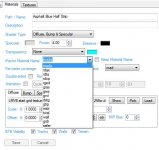Can anyone tell me about the differences in the road material under 'rFactor Material Name' in XPacker. I know they relate to what kind of driving surface/properties a material is, and some are obvious: GRAS = grass, GRVL = gravel, ROADA = road, RMBL = rumble (?), for example - but what do all the others do, what's the difference, when would I use them - and can I make my own types?!
Thanks...sorry if this is an obvious question....

Thanks...sorry if this is an obvious question....











